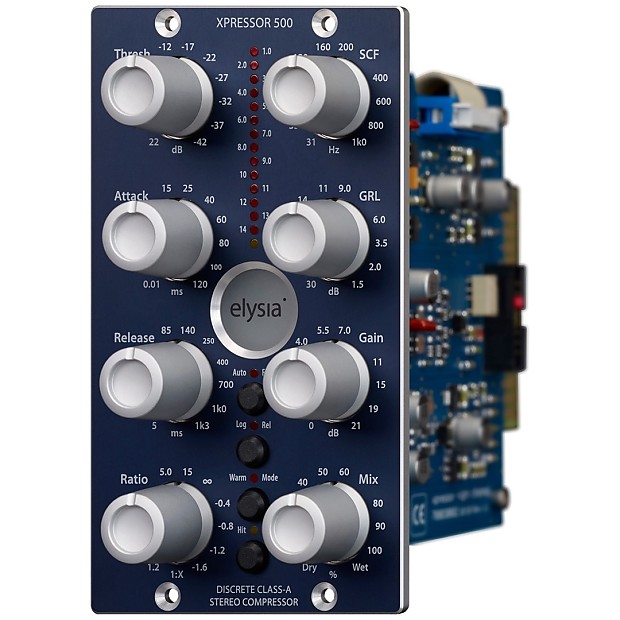Yes, we all love software plugin processors—but there's a lot to be said for analog processors, and their analog sound.
First, the bad news: Conventional analog signal processors that fit in 19" racks are bulky and expensive. But here's the good news: Compact, cost-effective 500-series modules are a modern alternative. Originally introduced by API decades ago, the concept started taking off in the early 2000s, and shows no sign of letting up.
500-series modules have gone way beyond their origins as a smaller alternative to conventional rack-based processing in studios—there are even guitarists and vocalists who use 500-series processing setups for live performance rigs.
Intrigued? Here are five reasons that help explain why the 500-series format continues to gain traction.
Reason No. 1
500-series modules are less expensive than standard rack gear.

There's a higher upfront cost, because you need to buy a frame (aka, a rack) that will hold your 500-series modules. However, because the frame includes a power supply (external or internal) and I/O for all your modules, you don't get hit with the cost of redundant power supplies, or the expensive metal enclosures, associated with multiple pieces of conventional rack gear.
The more modules you buy, the more that amortizes the rack's initial price. Also, some manufacturers produce 500-series modules that omit some features of rack-mount signal processors (for example, the 500-series version might lack a feature like big meters), but otherwise provide the same functionality at a much lower cost.
Reason No. 2
500-series modules are compact.

A 500-series rack takes up three conventional rack spaces (5.25" high) and can hold up to 11 modules instead of three single-rack-space processors. A lot of the space in conventional rack-mount gear is wasted in order to fit the format; 500-series modules are designed from the ground up to be compact.
Furthermore, there are smaller "lunchbox" racks that are designed for portability, and are popular for live setups. They typically hold up to six modules. You can even get a single-rack-space frame that holds up to three modules horizontally. The usual module size is 1.5" wide, but there are also double-wide and triple-wide modules that take up more space in order to include more controls or functionality.
Reason No. 3
They're easy to install and remove.
500-series modules have connectors on the back that plug into a "motherboard" on the back of the frame; a couple of screws attach the front panel to the frame. These modules are much easier to deal with than conventional rack units with "rack ears" that need a forest of patch cords coming out of their rear panel.
It's easy to upgrade or test one module in your 500-series rack—like swap out a new mic preamp, and leave the other modules alone. What's more, you can install your modules in a way that makes sense to the signal flow—start with a mic preamp on the left, and move right through de-esser, EQ, dynamics, and digital delay.
Reason No. 4
A huge selection means you can customize at will.

Compressors, mic preamps, equalizers, guitar processors, noise gates, tape emulators, headphone amps, re-amping modules—even laptop audio interfaces and Bluetooth streaming modules—are all available in 500-series form. There are also a lot of variations in the frame designs.
Some have XLR or TRS jacks for each slot, while others add internal mixers with level controls and panning—take this kind of "grab and go" frame for live performance, and you need to hook up only an input and output.
If you're focusing on mic preamps, you'll want a frame that offers +48V phantom power. With stereo setups, look for a frame that has internal switches to link modules for easy stereo operation.
Reason No. 5
DIYers are welcome here.
You can buy blank panels and connectors, drill out some holes for controls, add a connector, and rock out by adding your own custom modules to a 500-series frame... or even re-package your stompboxes into a 500-series format.
If you're a really hardy DIYer, you can even make your own rack system from scratch using enclosures and modules from Vector Electronics. The mind boggles.
Those are just some of the advantages to 500-series modules—they're not just about adding some analog mojo to your world of gear. For more information about specific modules, as well as Reverb's top picks in 500-series modules, see the Buying Guide on Essential 500-Series Modules.
About the author: Craig Anderton is an internationally recognized authority on musical technology. As a musician, producer, and engineer, he has played on or produced over 20 albums and has mastered hundreds of tracks. He has authored over 35 books and more than 1,000 articles for Guitar Player, Sound on Sound, Electronic Musician (which he co-founded), Pro Sound News, Mix, and several international publications. Visit his website here.
